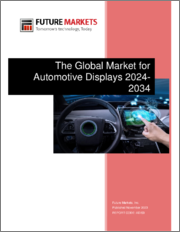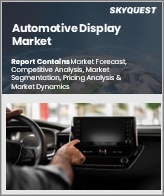
|
시장보고서
상품코드
1344577
세계의 자동차용 디스플레이 시장(2024-2034년)The Global Market for Automotive Displays 2024-2034 |
||||||
현대 자동차에서 자동차용 디스플레이 기술의 중요성은 점점 더 커지고 있습니다. 자동차용 디스플레이는 운전자와 차량 간의 상호작용을 위한 중요한 인터페이스이며, 엔터테인먼트 목적으로도 사용됩니다. 최근 수년간 자동차용 디스플레이 제조업체의 주문량이 크게 증가했으며, 특히 전기자동차(EV)와 자율주행의 부상으로 전자 기술의 발전과 함께 자동차용 디스플레이는 화면 이미지 표시뿐만 아니라 더 광범위한 역할을할 것으로 예상됩니다.
주요 시장 분야에는 인포테인먼트 시스템, 계기판, 헤드업 디스플레이, ADAS, 자율주행, 스마트 미러, 미니 LED, 마이크로 LED 등이 포함됩니다.
세계의 자동차용 디스플레이 시장에 대해 조사했으며, 시장의 개요와 시장 실적과 2034년까지의 예측, 디스플레이 유형별, 디스플레이 용도별 동향 및 시장에 참여하는 기업의 개요 등을 제공하고 있습니다.
목차
제1장 조사 방법
제2장 서론
- 자동차용 디스플레이의 진화
- 시장 동향
- 주요 디스플레이의 유형
- 자동차용 디스플레이 기술
- LCD
- OLED(OLED)
- TFT-LCD(박막 트랜지스터 LCD)
- 박막 일렉트로 루미네선스(TFEL) 디스플레이
- 헤드업 디스플레이(HUD)
- 3D 디스플레이
- 컴퓨터 생성 홀로그래피-(CGH)
- 라이트 필드 디스플레이(LFD)
- 공간 광 변조기
- 플렉서블 디스플레이
- 투명 디스플레이
- 곡면 디스플레이
제3장 세계 시장의 매출
- 디스플레이 유형별
- 디스플레이 용도별
제4장 인포테인먼트 시스템
- 개요
- IVI 시스템용 디스플레이 기술
- 시장 전망
제5장 계기판 디스플레이
- 개요
- 이점
- 계기판 디스플레이 기술
- 시장 전망
제6장 헤드업 디스플레이(HUD)
- 개요
- 동향
- 자동차에서 HUD 디스플레이 기술
- HUD 컨텐츠와 기능
- HUD를 탑재한 자동차용 모델
- 첨단 HUD
- 시장 전망
- 기업
제7장 플렉서블 및 곡면 디스플레이
- 기술
- 자동차 분야에서의 응용
- 시장이 해결해야 할 과제
- 시장 전망
- 기업
제8장 ADAS와 자율주행 디스플레이
- ADAS 센서
- 디스플레이 기술
- 시장 전망
- 기업
제9장 스마트 미러와 필라 디스플레이
- 주요 동향
- 스마트 미러 기술
- 필라 마운트 디스플레이
- 시장 전망
- 기업
제10장 3D 디스플레이
- 개요
- 자율주행차 3D 디스플레이
- 시장이 해결해야 할 과제
- 기업
제11장 투명 디스플레이
- 기술 개요
- 자동차 용도
- 시장이 해결해야 할 과제
- 기업
제12장 미니 LED 디스플레이
- 기술 개요
- 자동차 용도
- 기업
제13장 마이크로 LED 디스플레이
- 개요
- 자동차 분야에서의 응용
- 시장이 해결해야 할 과제
- 기업
제14장 스마트 글라스
- 스마트 조광
- 일렉트로크로믹 스마트 글래스
- 투명한 현탁입자 디바이스(SPD) 디스플레이
- 폴리머 분산형 액정(PDLC) 필름
- 서모크로믹 스마트 글래스
- 시장이 해결해야 할 과제
- 기업
제15장 기타 디스플레이 기술
- 양자점 디스플레이
- 전기영동 디스플레이
- 플라즈모닉 디스플레이
- 헤드업 콘택트렌즈
- 메타물질
제16장 기업 개요(66사의 기업 개요)
제17장 참고 자료
KSA 23.11.24Automotive display technologies are becoming increasingly important in modern vehicles. They are the key interface for the interaction between the driver and the vehicle, and are also used for entertainment purposes. Automotive display manufacturers have seen significant increase in order volumes of late and vehicle-mounted displays are expected to serve a broader role beyond displaying screen images as electronic technology advances, particularly with the rise of electric vehicles (EVs) and autonomous driving.
“The Global Market for Automotive Displays 2024-2034” covers the latest display technologies for automotive applications including LCD, OLED, TFT-LCD, TFEL, HUD, 3D, CGH, LFD, SLM, flexible, transparent, curved, quantum dot, electrophoretic, electrochromic, plasmonic displays, smart glass, and metamaterials.
Key market areas covered include infotainment systems, instrument clusters, head-up displays, ADAS, autonomous driving, smart mirrors, mini-LEDs, and micro-LEDs. The trends, benefits, limitations, and companies developing each display type are examined.
Contents include:
- Market trends, drivers and challenges.
- In-depth analysis and market outlook of display technologies for Automotive including:
- LCD (Liquid Crystal Display).
- OLED (Organic Light Emitting Diode).
- TFT-LCD (Thin Film Transistor LCD).
- Thin-film electroluminescent (TFEL) displays.
- Head-Up Displays (HUDs).
- 3D displays.
- Computer-Generated Holography (CGH).
- Light Field Displays (LFD).
- Spatial Light Modulators (SLM).
- Flexible displays.
- Transparent displays.
- Curved displays.
- Infotainment systems.
- Display Technologies for IVI Systems.
- Cluster displays.
- ADAS and autonomous driving displays.
- Smart mirrors and pillar displays.
- Smart glass.
- Mini-LED displays.
- Micro-LED displays.
- Quantum dot displays.
- Electrophoretic displays.
- Electrochromic displays.
- Plasmonic displays.
- Heads-up contact lens.
- Metamaterials.
- Global market revenues 2018-2034, by display type and technology. Regional analysis also provided.
- Profiles of 66 companies. Companies profiled include Continental, Envisics, Hyundai Mobis, LG Display, Samsung Display, TCL, Visteon and WayRay AG.
TABLE OF CONTENTS
1. RESEARCH METHODOLOGY
2. INTRODUCTION
- 2.1. Evolution of automotive displays
- 2.2. Market trends
- 2.3. Main types of displays
- 2.4. Display technologies for Automotive
- 2.4.1. LCD (Liquid Crystal Display)
- 2.4.1.1. Technology description
- 2.4.1.2. Advantages
- 2.4.1.3. Automotive applications
- 2.4.2. OLED (Organic Light Emitting Diode)
- 2.4.2.1. Technology description
- 2.4.2.2. Types of OLED technology
- 2.4.2.2.1. Active-matrix OLEDs (AMOLED)
- 2.4.2.2.2. Passive-matrix OLEDs (PMOLEDs)
- 2.4.2.2.3. Transparent OLEDs (TOLEDs)
- 2.4.2.2.4. Foldable/flexible OLED
- 2.4.2.2.5. Tandem OLEDs
- 2.4.2.3. Automotive applications
- 2.4.2.4. Companies
- 2.4.3. TFT-LCD (Thin Film Transistor LCD)
- 2.4.3.1. Technology description
- 2.4.3.2. Advantages
- 2.4.3.3. TFT-LCD Backlight Technologies
- 2.4.3.4. Diffusers
- 2.4.3.5. Automotive applications
- 2.4.3.6. Companies
- 2.4.4. Thin-film electroluminescent (TFEL) displays
- 2.4.4.1. Technology description
- 2.4.4.2. Automotive applications
- 2.4.4.3. Commercialization
- 2.4.5. Head-Up Displays (HUDs)
- 2.4.5.1. Technology description
- 2.4.5.2. Automotive applications
- 2.4.6. 3D displays
- 2.4.6.1. Technology description
- 2.4.6.2. Automotive applications
- 2.4.7. Computer-Generated Holography (CGH)
- 2.4.7.1. Technology description
- 2.4.7.2. Advantages
- 2.4.7.3. Full 3D displays
- 2.4.7.4. Next-gen heads-up displays (HUDs)
- 2.4.7.5. Automotive applications
- 2.4.7.6. Companies
- 2.4.8. Light Field Displays (LFDs)
- 2.4.8.1. Technology description
- 2.4.8.2. Spatial light field displays
- 2.4.8.3. Sequential light field displays
- 2.4.8.4. Automotive applications
- 2.4.8.5. Companies
- 2.4.9. Spatial Light Modulators
- 2.4.9.1. Technology description
- 2.4.9.2. Liquid crystal (LC) spatial light modulators (SLMs)
- 2.4.9.2.1. Fabricating LCOS SLMs
- 2.4.9.3. Transmissive LC panels
- 2.4.9.4. Optically addressed SLM
- 2.4.9.5. Digital micromirror device (DMD) spatial light modulators (SLMs)
- 2.4.9.6. Automotive applications
- 2.4.9.7. Companies
- 2.4.10. Flexible displays
- 2.4.10.1. Technology description
- 2.4.10.1.1. Organic LCDs
- 2.4.10.1.2. Organic light-emitting diodes (OLEDs)
- 2.4.10.1.3. Inorganic LEDs
- 2.4.10.1.4. Flexible AMOLED
- 2.4.10.1.5. Printed OLED
- 2.4.10.2. Automotive applications
- 2.4.10.1. Technology description
- 2.4.11. Transparent displays
- 2.4.11.1. Overview
- 2.4.11.2. Automotive applications
- 2.4.12. Curved displays
- 2.4.12.1. Overview
- 2.4.12.2. Automotive applications
- 2.4.12.3. Companies
- 2.4.1. LCD (Liquid Crystal Display)
3. GLOBAL MARKET REVENUES
- 3.1. By display type
- 3.2. By display application
4. INFOTAINMENT SYSTEMS
- 4.1. Overview
- 4.1.1. Trends
- 4.1.2. Interior displays
- 4.1.3. Center information displays (CIDs)
- 4.1.3.1. Companies
- 4.1.4. Touchscreens
- 4.1.5. Large screens
- 4.1.6. Enhanced safety with in-vehicle displays
- 4.2. Display Technologies for IVI Systems
- 4.2.1. Human Machine Interface Design
- 4.2.2. Augmented reality navigation
- 4.2.3. Gesture and gaze tracking for touchless control
- 4.2.4. Biometric sensors
- 4.2.5. Transparent OLED windows
- 4.2.6. Customized screens
- 4.2.7. Dual screen layouts
- 4.2.8. Ambient lighting integration
- 4.3. Market outlook
5. INSTRUMENT CLUSTER DISPLAYS
- 5.1. Overview
- 5.1.1. Trends
- 5.1.2. Key factors driving adoption
- 5.2. Benefits
- 5.3. Display Technologies for Instrument Clusters
- 5.3.1. Configurable Clusters
- 5.3.2. Full LCD Clusters
- 5.3.3. Augmented Reality Clusters
- 5.3.4. Holographic Clusters
- 5.4. Market outlook
6. HEAD-UP DISPLAYS (HUD)
- 6.1. Overview
- 6.2. Trends
- 6.3. HUD Display Technologies in automotive
- 6.3.1. Projection displays
- 6.3.2. Combiner HUD
- 6.3.3. AR-HUDs
- 6.4. HUD Content and Features
- 6.5. Automotive models incorporating HUDs
- 6.6. Advanced HUDs
- 6.6.1. Panoramic HUD
- 6.6.2. Holographic 3D displays
- 6.6.3. Adaptive displays
- 6.6.4. Conformal HU
- 6.7. Market Outlook
- 6.8. Companies
7. FLEXIBLE AND CURVED DISPLAYS
- 7.1. Technologies
- 7.2. Applications in automotive
- 7.3. Market challenges
- 7.4. Market outlook
- 7.5. Companies
8. ADAS AND AUTONOMOUS DRIVING DISPLAYS
- 8.1. ADAS sensors
- 8.2. Display technologies
- 8.2.1. Touchless/gesture human-machine interfaces (HMI)
- 8.2.2. Transparent displays
- 8.2.3. 3D displays
- 8.2.4. Flexible displays
- 8.2.5. AR/VR integration
- 8.3. Market outlook
- 8.4. Companies
9. SMART MIRRORS AND PILLAR DISPLAYS
- 9.1. Key trends
- 9.2. Smart Mirror Technologies
- 9.2.1. Digital side mirrors
- 9.2.2. E-mirror
- 9.2.3. Smart rearview mirror
- 9.2.4. Key benefits of smart mirrors
- 9.3. Pillar-Mounted Displays
- 9.3.1. Types
- 9.3.2. Benefits
- 9.4. Market Outlook
- 9.5. Companies
10. 3D DISPLAYS
- 10.1. Overview
- 10.2. 3D displays in autonomous vehicles
- 10.2.1. Multiview 3D displays
- 10.2.1.1. Description
- 10.2.1.2. Approaches
- 10.2.1.3. Integral imaging technologies
- 10.2.2. Spatial LFDs
- 10.2.3. Computer-generated holography (CGH) displays
- 10.2.1. Multiview 3D displays
- 10.3. Market challenges
- 10.4. Companies
11. TRANSPARENT DISPLAYS
- 11.1. Technology overview
- 11.2. Automotive applications
- 11.2.1. Side windows
- 11.2.2. Smart windows
- 11.2.3. Micro-LEDS
- 11.2.4. HUD enhancement
- 11.2.5. Privacy partitions
- 11.3. Market challenges
- 11.4. Companies
12. MINI-LED DISPLAYS
- 12.1. Technology overview
- 12.1.1. Quantum dot films for Mini-LED displays
- 12.1.2. Perovskite colour enhancement film in Mini-LEDs
- 12.2. Automotive applications
- 12.2.1. Dashboard Displays
- 12.2.2. Head-Up Displays (HUDs)
- 12.2.3. Digital Instrument Clusters
- 12.2.4. Ambient Lighting
- 12.2.5. Exterior Lighting
- 12.3. Companies
13. MICRO-LED DISPLAYS
- 13.1. Overview
- 13.1.1. Display configurations
- 13.1.2. Transparency
- 13.1.3. Borderless
- 13.1.4. Flexibility
- 13.2. Applications in automotive
- 13.2.1. Flexible Displays
- 13.2.2. Transparent Displays
- 13.2.3. Splicing displays
- 13.2.4. Signalling & communication
- 13.2.5. Head-up display (HUD)
- 13.2.6. Lighting (Automotive matrix headlamps, intelligent lighting)
- 13.3. Market challenges
- 13.4. Companies
14. SMART GLASS
- 14.1. Smart dimming
- 14.2. Electrochromic smart glass
- 14.2.1. Inorganic metal oxides
- 14.2.2. Organic EC materials
- 14.2.3. Nanomaterials
- 14.2.4. Benefits
- 14.2.5. Shortcomings
- 14.2.6. Automotive applications
- 14.3. Transparent suspended particle device (SPD) displays
- 14.3.1. Automotive applications
- 14.4. Polymer dispersed liquid crystal (PDLC) films
- 14.4.1. Automotive applications
- 14.5. Thermochromic smart glass
- 14.5.1. Technology description
- 14.5.2. Benefits
- 14.5.3. Shortcomings
- 14.5.4. Automotive applications
- 14.6. Market challenges
- 14.7. Companies
15. OTHER DISPLAY TECHNOLOGIES
- 15.1. Quantum dot displays
- 15.1.1. Overview
- 15.1.1.1. Mode of operation
- 15.1.1.2. Types of quantum dots
- 15.1.2. Automotive applications
- 15.1.1. Overview
- 15.2. Electrophoretic displays
- 15.2.1. Overview
- 15.2.2. Automotive applications
- 15.3. Plasmonic displays
- 15.3.1. Overview
- 15.3.2. Automotive applications
- 15.4. Heads-up contact lens
- 15.4.1. Overview
- 15.4.2. Automotive applications
- 15.5. Metamaterials
- 15.5.1. Overview
- 15.5.1.1. Metasurfaces
- 15.5.1.2. Meta-Lens
- 15.5.1.3. Metasurface holograms
- 15.5.1.4. Flexible metasurfaces
- 15.5.2. Automotive applications
- 15.5.2.1. Holographic displays
- 15.5.2.2. AR/VR
- 15.5.2.3. Multiview displays
- 15.5.2.4. Stretchable displays
- 15.5.2.5. Soft materials
- 15.5.2.6. Anti-reflection coatings
- 15.5.1. Overview



















